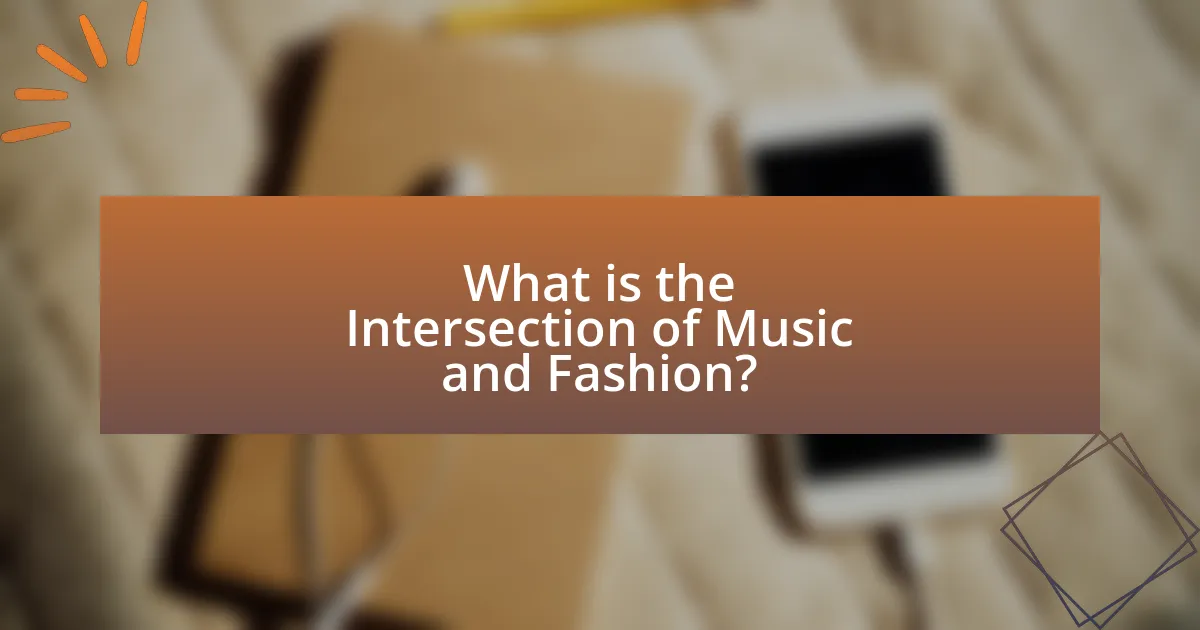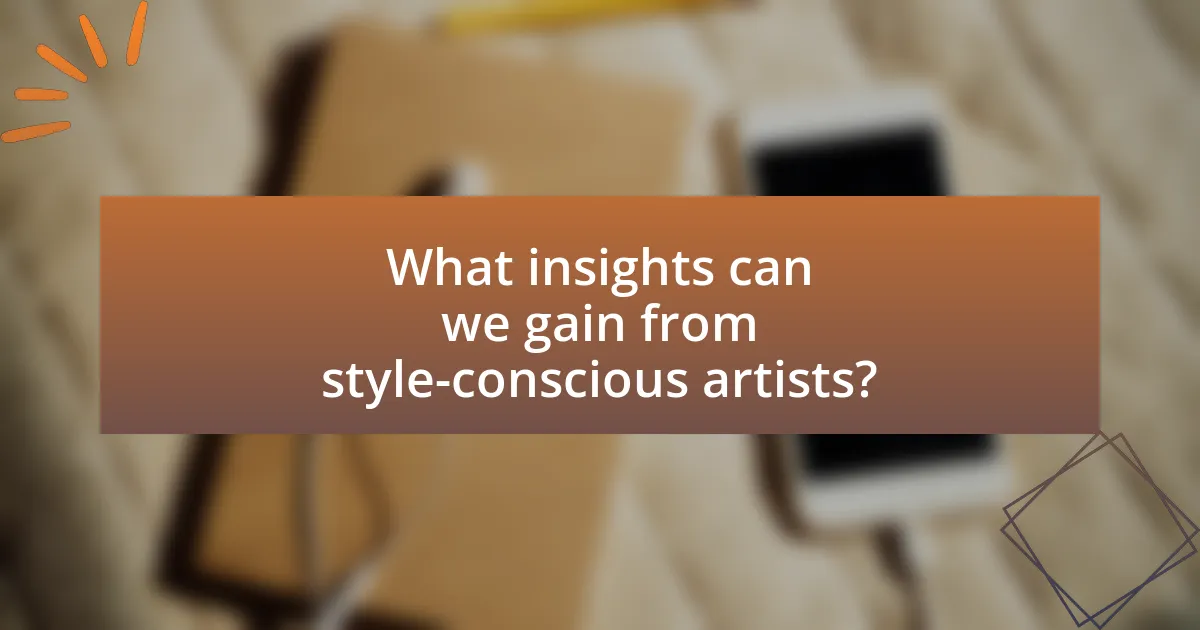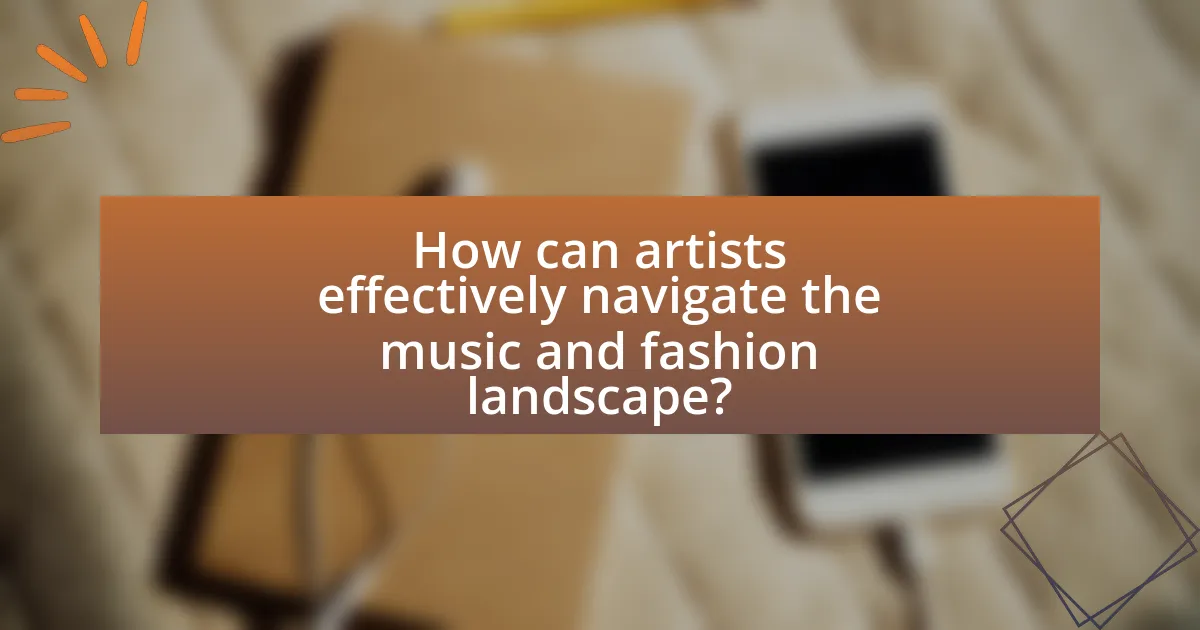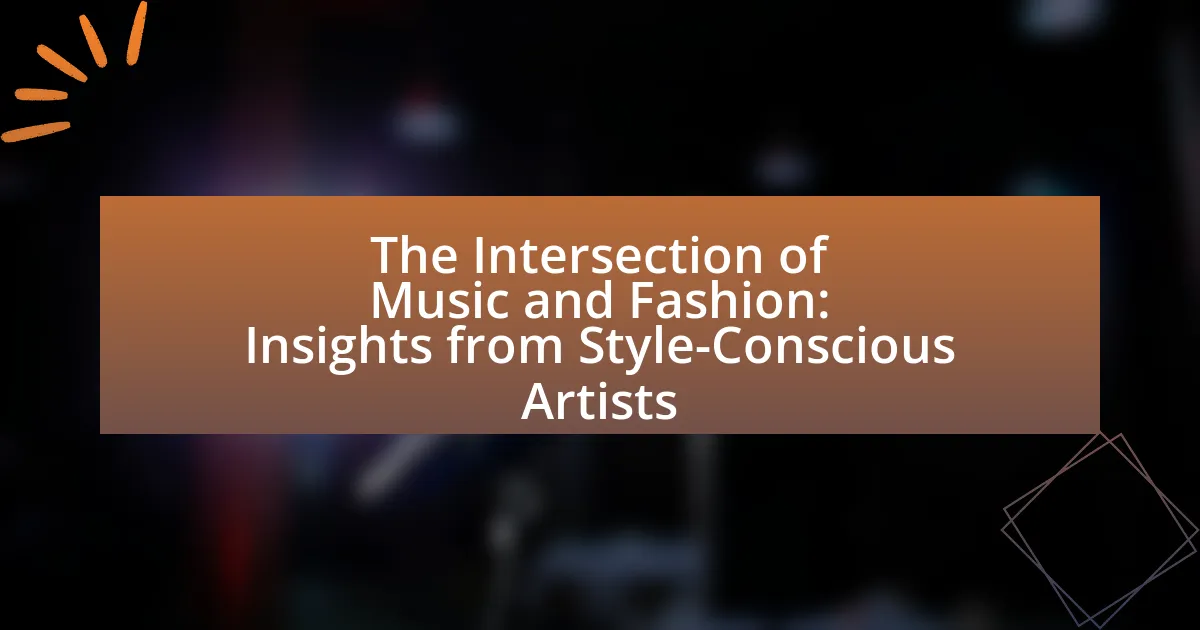The article explores the intersection of music and fashion, highlighting how musical genres influence clothing styles and vice versa. It examines historical examples, such as the punk movement and the impact of artists like Elvis Presley and Madonna, to illustrate the cultural significance of this relationship. The discussion includes how artists use fashion for self-expression, the importance of personal style in shaping brand identity, and current trends in music-related fashion, such as streetwear and sustainability. Additionally, it addresses the challenges artists face in maintaining authenticity while navigating industry expectations and the role of social media in shaping fashion trends within the music industry.

What is the Intersection of Music and Fashion?
The intersection of music and fashion is the dynamic relationship where musical genres influence clothing styles and vice versa. This connection is evident in various music movements, such as punk, hip-hop, and rock, where artists use fashion as a form of self-expression and cultural identity. For instance, the punk movement of the 1970s showcased a distinct style characterized by leather jackets, ripped jeans, and bold hairstyles, which reflected the rebellious spirit of the music. Similarly, hip-hop culture has popularized streetwear brands and oversized clothing, shaping mainstream fashion trends. This interplay highlights how artists not only create music but also set fashion trends that resonate with their audiences, reinforcing their artistic identity and cultural narratives.
How do music and fashion influence each other?
Music and fashion influence each other through cultural expression and identity formation. Artists often use fashion to convey their musical style and persona, while fashion designers draw inspiration from musical trends and subcultures. For example, the punk movement in the 1970s saw musicians like the Sex Pistols influencing fashion with their distinctive styles, which included ripped clothing and bold accessories. Conversely, fashion icons such as Madonna in the 1980s popularized specific music genres through their unique styles, creating a symbiotic relationship where each domain enhances the other’s visibility and cultural relevance. This interplay is evident in contemporary collaborations between musicians and fashion brands, further solidifying their mutual influence.
What historical examples illustrate the connection between music and fashion?
Historical examples illustrating the connection between music and fashion include the 1950s rock and roll era, where artists like Elvis Presley popularized leather jackets and pompadour hairstyles, influencing youth culture and fashion trends. Additionally, the punk movement of the 1970s, led by bands like the Sex Pistols, showcased a distinct style characterized by ripped clothing, safety pins, and bold hairstyles, which became synonymous with the genre. In the 1980s, Madonna’s fashion choices, including lace gloves and layered jewelry, not only defined her image but also set trends that resonated with fans and the broader fashion industry. These examples demonstrate how musicians have historically shaped fashion trends, reflecting cultural shifts and influencing societal norms.
How do cultural movements shape the relationship between music and fashion?
Cultural movements significantly shape the relationship between music and fashion by influencing trends, aesthetics, and identity expression. For instance, the punk movement of the 1970s introduced a rebellious style characterized by ripped clothing and bold accessories, which mirrored the raw sound of punk music. This synergy between the aggressive musical genre and its fashion counterpart created a distinct cultural identity that resonated with youth disillusionment. Similarly, the hip-hop movement has transformed fashion through the adoption of streetwear, oversized clothing, and luxury brands, reflecting the genre’s roots in urban culture and social commentary. The integration of music and fashion within these movements illustrates how they collectively express societal values and individual identities, reinforcing their interconnectedness.
Why is style important for artists in the music industry?
Style is important for artists in the music industry because it serves as a key differentiator that shapes their identity and brand. A distinct style allows artists to express their individuality, connect with their audience, and create a memorable image that resonates in a competitive market. For instance, artists like Lady Gaga and David Bowie have utilized their unique fashion choices to enhance their musical personas, leading to increased visibility and commercial success. This connection between style and music is supported by research indicating that visual aesthetics significantly influence audience perception and engagement, reinforcing the idea that style is not merely an accessory but a fundamental aspect of an artist’s overall impact in the industry.
How does an artist’s fashion sense impact their brand image?
An artist’s fashion sense significantly impacts their brand image by shaping public perception and influencing audience engagement. For instance, artists like Lady Gaga and David Bowie have utilized distinctive fashion choices to create memorable personas that resonate with their music, thereby enhancing their brand identity. Research indicates that 70% of consumers associate an artist’s style with their music, suggesting that fashion is a critical component of an artist’s overall image. This connection between fashion and brand image can lead to increased fan loyalty and marketability, as unique styles often attract media attention and social media buzz, further solidifying the artist’s presence in the industry.
What role does personal style play in an artist’s performance and public perception?
Personal style significantly influences an artist’s performance and public perception by shaping their identity and enhancing audience engagement. An artist’s unique fashion choices can create a memorable image that resonates with fans, often leading to increased visibility and marketability. For instance, artists like David Bowie and Lady Gaga have utilized distinctive styles to establish strong personal brands, which not only attract attention but also foster a deeper emotional connection with their audience. This connection can enhance live performances, as audiences are often more engaged when they feel aligned with an artist’s aesthetic. Furthermore, studies show that visual presentation can impact audience perceptions of an artist’s talent and authenticity, reinforcing the idea that personal style is integral to both performance dynamics and public image.
What are the key trends in music-related fashion today?
Key trends in music-related fashion today include the rise of streetwear, the influence of vintage aesthetics, and the integration of sustainable practices. Streetwear has become a dominant style, with artists like Travis Scott and Billie Eilish popularizing oversized silhouettes and graphic tees. Vintage aesthetics are also prevalent, as musicians draw inspiration from past decades, often incorporating retro patterns and styles into their wardrobes. Additionally, sustainability is increasingly important, with many artists advocating for eco-friendly fashion choices, such as upcycled materials and ethical brands, reflecting a broader cultural shift towards environmental consciousness in the fashion industry.
Which fashion styles are currently popular among musicians?
Currently, oversized streetwear and vintage-inspired clothing are popular fashion styles among musicians. Artists like Billie Eilish and Tyler, The Creator frequently showcase oversized silhouettes, graphic tees, and baggy pants, reflecting a casual yet bold aesthetic. Additionally, the resurgence of 90s and early 2000s fashion, characterized by elements such as bucket hats, platform shoes, and colorful prints, has been embraced by various musicians, including Harry Styles and Dua Lipa. This trend is supported by social media platforms, where musicians share their outfits, influencing fans and setting new fashion standards.
How do social media and digital platforms influence fashion trends in music?
Social media and digital platforms significantly influence fashion trends in music by providing artists with a direct channel to showcase their style and connect with fans. Platforms like Instagram and TikTok allow musicians to share visual content, such as outfits worn during performances or music videos, which can quickly go viral and set new fashion trends. For instance, the rise of TikTok has led to the popularity of specific clothing brands and styles, as users replicate the looks of trending artists. Additionally, collaborations between musicians and fashion brands are often promoted through these platforms, further blurring the lines between music and fashion. This dynamic interaction creates a feedback loop where fashion trends in music are continuously shaped and reshaped by audience engagement and social media visibility.
How do artists use fashion to express their identity?
Artists use fashion as a medium to convey their identity by selecting clothing and accessories that reflect their personal beliefs, cultural backgrounds, and artistic visions. For instance, musicians often adopt specific styles that resonate with their genre, such as punk rock artists embracing leather jackets and distressed jeans to symbolize rebellion and nonconformity. This choice of attire not only enhances their public persona but also communicates messages about their values and experiences. Historical examples include David Bowie, who utilized flamboyant costumes to challenge gender norms and express fluidity in identity, thereby influencing cultural perceptions of self-expression.
What are some examples of artists who have successfully merged music and fashion?
Artists such as Rihanna, Kanye West, and Beyoncé have successfully merged music and fashion. Rihanna launched her Fenty Beauty line and Savage X Fenty lingerie brand, showcasing her influence in both industries. Kanye West’s Yeezy brand has transformed streetwear and sneaker culture, with his collaborations with Adidas achieving significant commercial success. Beyoncé’s Ivy Park activewear line, in partnership with Adidas, emphasizes her impact on fashion while promoting body positivity and inclusivity. These artists exemplify the integration of music and fashion, leveraging their platforms to create influential brands that resonate with their audiences.
How does fashion serve as a form of self-expression for musicians?
Fashion serves as a vital form of self-expression for musicians by allowing them to convey their identity, artistic vision, and cultural influences visually. Through their clothing choices, musicians can communicate messages about their music, personal beliefs, and social issues, often reflecting their unique styles and the genres they represent. For example, artists like David Bowie and Lady Gaga have utilized fashion to challenge norms and create personas that resonate with their audiences, effectively using visual aesthetics to enhance their musical narratives. This connection between fashion and music is further supported by the fact that many musicians collaborate with designers, creating iconic looks that become synonymous with their brands, thereby solidifying the role of fashion in their artistic expression.

What insights can we gain from style-conscious artists?
Style-conscious artists provide insights into the powerful relationship between personal expression and cultural trends. Their fashion choices often reflect broader societal movements, influencing public perceptions and shaping industry standards. For instance, artists like David Bowie and Lady Gaga have used their unique styles to challenge gender norms and promote individuality, demonstrating how fashion can serve as a medium for social commentary. Additionally, studies show that artists who prioritize style can enhance their brand identity, leading to increased marketability and fan engagement, as seen in the rise of fashion collaborations in the music industry.
How do artists curate their personal style?
Artists curate their personal style by blending their musical influences with visual aesthetics that resonate with their identity. This process often involves selecting clothing, accessories, and overall presentation that reflect their artistic vision and personal experiences. For instance, many artists draw inspiration from cultural movements, historical fashion trends, and their own life stories, allowing them to create a unique visual narrative that complements their music. This curated style not only enhances their artistic expression but also helps in establishing a recognizable brand in the competitive music industry.
What factors influence an artist’s fashion choices?
An artist’s fashion choices are influenced by personal identity, cultural background, and industry trends. Personal identity shapes an artist’s unique style, reflecting their beliefs and experiences. Cultural background provides a rich tapestry of influences, including traditional attire and regional styles that inform their fashion decisions. Industry trends, driven by social media, celebrity culture, and fashion designers, also play a significant role, as artists often align their image with current fashion movements to enhance their marketability and connect with audiences. For instance, the rise of streetwear in music has led many artists to adopt casual, urban styles that resonate with younger fans.
How do collaborations with fashion designers impact an artist’s style?
Collaborations with fashion designers significantly influence an artist’s style by integrating unique aesthetic elements and trends into their visual identity. When artists partner with fashion designers, they often adopt new clothing styles, colors, and materials that reflect the designer’s vision, thereby enhancing their personal brand. For instance, artists like Rihanna and Beyoncé have collaborated with high-profile designers, resulting in distinctive fashion statements that resonate with their music and public personas. This synergy not only elevates the artist’s image but also allows them to reach broader audiences, as seen in Rihanna’s Fenty line, which merges her musical artistry with innovative fashion, creating a cultural impact that extends beyond music.
What challenges do artists face in the intersection of music and fashion?
Artists face several challenges at the intersection of music and fashion, primarily including the pressure to maintain a cohesive brand identity and the risk of cultural appropriation. The need for a consistent image that aligns with their musical style can lead to conflicts between artistic expression and commercial expectations. Additionally, artists often navigate the fine line between inspiration and appropriation, as borrowing elements from different cultures can result in backlash if not done respectfully. This complexity is evident in cases like the criticism faced by artists who adopt fashion trends without acknowledging their origins, highlighting the importance of cultural sensitivity in both music and fashion.
How do industry expectations shape an artist’s fashion decisions?
Industry expectations significantly influence an artist’s fashion decisions by dictating trends and standards that artists feel compelled to follow to maintain relevance. For instance, in the music industry, genres often have associated styles; pop artists typically adopt vibrant, eye-catching outfits, while rock musicians may lean towards a more edgy aesthetic. This alignment with genre-specific fashion helps artists connect with their target audience and enhances their marketability. Additionally, major fashion brands often collaborate with artists, further pressuring them to adopt specific styles that align with brand identities, as seen in partnerships like Rihanna with Puma or Beyoncé with Ivy Park. Such collaborations not only shape individual fashion choices but also set broader industry trends that other artists may emulate to stay competitive.
What are the risks of fashion missteps for musicians?
Fashion missteps for musicians can lead to significant risks, including damage to their public image and potential loss of fan support. When musicians fail to align their fashion choices with their brand identity or the expectations of their audience, they may face backlash, which can manifest in negative media coverage or social media criticism. For instance, a study by the University of Southern California found that artists who are perceived as inauthentic in their style choices can experience a decline in fan engagement and loyalty. Additionally, fashion missteps can overshadow musical talent, diverting attention from their work and impacting commercial success, as seen in cases where artists’ controversial outfits have sparked more discussion than their music.
What can emerging artists learn from established style-conscious musicians?
Emerging artists can learn the importance of personal branding and visual identity from established style-conscious musicians. These musicians often use fashion as a tool to enhance their artistic expression and connect with their audience, creating a memorable image that complements their music. For instance, artists like David Bowie and Lady Gaga have successfully integrated unique fashion choices into their personas, which not only set them apart but also contributed to their commercial success. This demonstrates that a strong visual identity can amplify an artist’s message and increase their visibility in a competitive industry.
How can new artists develop their unique fashion identity?
New artists can develop their unique fashion identity by exploring personal aesthetics, experimenting with various styles, and drawing inspiration from diverse cultural influences. This process involves self-reflection to identify what resonates with their artistic vision, allowing them to curate a wardrobe that reflects their individuality. For instance, artists like Billie Eilish have successfully crafted distinct fashion identities by embracing bold colors and oversized silhouettes, which align with their music’s themes. Additionally, engaging with fashion history and current trends can provide context and depth, enabling artists to make informed choices that set them apart in the industry.
What strategies can artists use to effectively blend music and fashion?
Artists can effectively blend music and fashion by creating a cohesive brand identity that integrates their musical style with their fashion choices. This strategy involves selecting clothing and accessories that reflect the themes and emotions of their music, thereby enhancing their overall artistic expression. For instance, artists like Lady Gaga and Pharrell Williams have successfully merged their music with distinctive fashion statements, using their attire to convey messages and connect with their audience on a deeper level. Additionally, collaborations with fashion designers can elevate an artist’s visibility and credibility in the fashion world, as seen with Rihanna’s partnership with Puma, which not only showcased her musical talent but also her fashion influence. By leveraging social media platforms, artists can share their fashion choices alongside their music, creating a visual narrative that resonates with fans and strengthens their brand.

How can artists effectively navigate the music and fashion landscape?
Artists can effectively navigate the music and fashion landscape by strategically aligning their brand identity with current trends while maintaining authenticity. This involves staying informed about fashion trends, collaborating with designers, and utilizing social media platforms to showcase their unique style. For instance, artists like Billie Eilish have successfully integrated their music and fashion by creating a distinct visual identity that resonates with their audience, leading to increased visibility and brand loyalty. Additionally, research from the Journal of Fashion Marketing and Management indicates that artists who engage in cross-industry collaborations can enhance their market reach and influence, demonstrating the importance of synergy between music and fashion.
What best practices should artists follow in their fashion choices?
Artists should prioritize authenticity and personal expression in their fashion choices. This means selecting clothing that reflects their unique identity and artistic vision, which can enhance their brand and connect with their audience. Research indicates that artists who align their fashion with their personal style are often perceived as more relatable and genuine, fostering a stronger connection with fans. Additionally, artists should consider the context of their performances or public appearances, ensuring their outfits are appropriate for the setting while still showcasing their individuality. This approach not only reinforces their artistic persona but also helps in creating memorable visual impressions that resonate with their audience.
How can artists maintain authenticity while experimenting with fashion?
Artists can maintain authenticity while experimenting with fashion by staying true to their personal style and values. This involves integrating elements that reflect their identity and artistic vision, rather than conforming to fleeting trends. For instance, musicians like David Bowie and Lady Gaga have successfully blended their unique aesthetics with fashion, creating iconic looks that resonate with their artistic narratives. By prioritizing self-expression over commercial appeal, artists can ensure that their fashion choices enhance their authenticity rather than dilute it.
What resources are available for artists looking to enhance their style?
Artists looking to enhance their style can utilize various resources, including online courses, workshops, and mentorship programs. Online platforms like Skillshare and Coursera offer courses specifically focused on artistic techniques and style development, allowing artists to learn from industry professionals. Additionally, local art schools and community centers often host workshops that provide hands-on experience and feedback. Mentorship programs, such as those offered by organizations like the Creative Capital Foundation, connect emerging artists with established professionals for guidance and inspiration. These resources collectively support artists in refining their unique styles and expanding their creative horizons.
